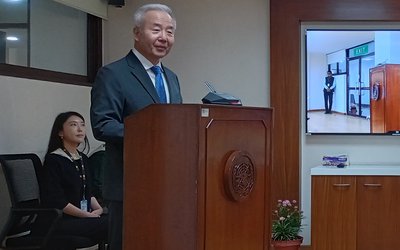Following the ban by Nepal government on certain plastic bags in 2015, plastic goods producers have come forward in an organized way to debate with the concerned stakeholders about the issues of how to maximize the benefits of plastic products and reduce the environmental damage to the minimum.
After years of campaigns of environmentalists and NGOs on harmful impacts of low quality plastic bags, the government issued an order to ban the use of certain plastic bags all over Nepal in April 14, 2015.
Now the debate has started on how to reduce use of plastic bags, reuse and recycle them. At a program organized by Plastic Nepal Foundation and Plastic India Foundation, participants representing various stakeholders agreed to take the necessary steps to use the plastic products with caution by utilizing them for maximum benefits.
Plastic products are everywhere in human life. A range of items from glasses to mobiles or shoes to watches, are available as plastic products. Even the departmental stores cannot run without using the plastic. Be it in a utensil or car, the use of plastic has increased. Whether it be drinking water supply work or construction of tunnel for agriculture products, plastic goods are widely used.
Nepal’s many small drinking water and irrigation systems are impossible without the use of plastic products. In the last many years, everything has changed in Nepal. The public pressure to reduce the use of plastic has also increased with arguments against the many harmful effects of the material.
As the debate is growing, proponents and opponents came face to face in a workshop held in Kathmandu recently. The workshop was inaugurated by Minister of Industry Nabindra Raj Joshi.
The foundation was established with an aim to promote plastics in the country, promote Nepal as a plastic destination and to create awareness of plastics and its benefits among its consumers and respective government and public bodies.
“Plastics are one of the fastest growing industries in Nepal and it has a vital role to play in Nepalese economy, contributing big revenues, thereby contributing in nation building. The next two decades will witness an unprecedented, explosive growth in all sectors of Plastics Industry with the demands clear, in pursuit of long term constructive goals and a time-bound action program,” said Anand Mal Vaidya, vice president of Nepal Plastic Foundation in the program.
Plastic Nepal Foundation is the apex body of major associations, organizations, and institutions connected with plastics, with common objectives to promote the development of the plastics industry and to assist the growth of plastics and related materials and their products.
“Plastic industries are suffering from the government decision to ban their products. As plastic import is in the negative list, the tariff is very high. Although plastic related products have been contributing immensely in nation building, it is getting the negative publicity,” said Pradeep Kumar Shrestha, former president of Federation of Nepalese Chamber of Commerce. "The term plastic is misused in Nepal.”
With an aim to act as the catalyst for growth to the plastics industry and prepare plans and actions for upgrade of the product quality, environment-friendliness and recycling within the plastics industry, Plastic Nepal Foundation had organized the international workshop.
Moderated by Bharat Raj Acharya, president of TSN Corporation, the half-day workshop saw full-fledged interactions among different stakeholders involved in the plastic products.
Harmful Effects
Despite the claims of the business community, plastic items have some harmful effects on human life. They also generate toxic chemicals such as bisphenol A and polystyrene, which can leak into water. Polystyrene pieces and hurdles are the most common types of plastic pollution and combined with plastic bags.
“Plastics are a part of our daily lives. Unfortunately, that doesn’t mean they’re safe or responsible. A closer understanding of the harmful effects of plastic will empower us to improve their toxic footprint,” said Prashant Singh, president of Himalayan Climate Initiative, an NGO that had played a lead role in the call to ban plastic bags in Nepal. “We are not opposing the use of plastic but our concern is how to protect the environment from its chemical harm.”
While the industrial development of plastic in many ways made life easier, plastic production impacts every phase of the life cycle. “Of course, the plastic has changed our life. It does not mean that we should support the use of it blankly. I am not against the use of plastic but what I am much concerned about is how to recycle, reuse and reduce it,” said Ganesh Shah, former minister of science and technology and environment.
The impacts of plastic production in its many forms are heavy in every phase of its life cycle. While there is a common general understanding that plastics have negative ecological associations, a closer understanding of what types of plastics create what types of impacts will empower us to improve the toxic footprint of our buildings.
“Plastics are not inherently bad and they have good features as well. However, there are many negative stories running against it,” said Atul Kanuga, chairman of Environment and Plastic Image Committee of PlastIndia Foundation.
“Their durability and low maintenance reduce material replacement, their light weight reduces shipping energy, their formulation into glue products allows for the creation of engineered lumber and sheet products from recycled wood, and their formulation into superior insulation and sealant products improve the energy performance of our structures.”
The feedstock of plastic is primarily petroleum- or natural-gas-derived. Toxic chemical release during manufacture is significant source of the negative environmental impact of plastics. A whole host of carcinogenic, neurotoxic, and hormone-disruptive chemicals are standard ingredients and waste products of plastic production, and they inevitably find their way into our ecology through water, land, and air pollution.
Some of the more familiar compounds include vinyl chloride (in PVC), dioxins (in PVC), benzene (in polystyrene), phthalates and other plasticizers (in PVC and others), formaldehyde, and bisphenol-A, or BPA (in polycarbonate).
Many of these are persistent organic pollutants (POPs)—some of the most damaging toxins on the planet, owing to a combination of their persistence in the environment and their high levels of toxicity.
“Import, export, sales, distribution and use of plastic and polypropylene bags would be banned to eliminate their negative effects on human health, environment, and urban beauty,” said Ganesh Kumar Shrestha, director general at Department of Environment (DoE).
Nepal imports 170,000 metric tons of plastic annually.
The Plastic Bag Directive- 2071 had restricted production, sale, and distribution of plastic bags below 30 microns. The Department of Environment said it is preparing to bring a new directive to impose the blanket ban on plastic bags throughout the country.
With the massive use and misuse of plastic bags and plastic bottles, Nepal’s rivers and mountains have concentration of waste plastic. Kathmandu Valley’s sewer system is badly affected by plastic bags.
Recycle and Reuse
The solution of the present crisis is to recycle and reuse the products. If things happen that way, the import will be reduced and Nepal also can get the maximum benefits. “Banning the plastic is not a long run solution. The government wants to encourage more recycled industries so that people can reuse the products,” said Rishi Raj Koirala, joint secretary of Ministry of Industry. “The government is considering to bring new policy towards it.”
There is broader negative perception regarding the use of plastic. The plastic product, which needs over 400 years to be degraded in nature, has already reached overcapacity of landfill in Kathmandu.
“Nepal’s per capita of plastic is very negligible. What went wrong is that there is massive negative publicity. There is the need to do objective analysis of its contribution,” said Anand Mal Baid of Plast Nepal Foundation. “Plastic is not luxury but a neckwear.”
As Nepal has over four decades of history of use of plastic, there is yet to have national recycling policy and it has not been taken as part of waste management. “If plastic is properly recycled, all the problems can be settled,” said Acharya.
As plastic is not good for environment, there is no alternative either to replace it. What needs to be done is to reduce and reuse it to finally reduce the import of the products.

Keshab Poudel
Poudel is the editor of New Spotlight Magazine.
- FM Dr. Deuba’s India Visit: Mission Aborted
- Mar 26, 2025
- AMBASSADOR MAEDA TORU: Warm Regards
- Mar 24, 2025
- PRO-MONARCHY MOVEMENT: Rising Dissatisfaction
- Mar 23, 2025
- Dr. PRABIN MANANDHAR: Person With Humility
- Mar 16, 2025
- US SUSPESION OF GRANT: Impact On Nepal
- Mar 10, 2025















